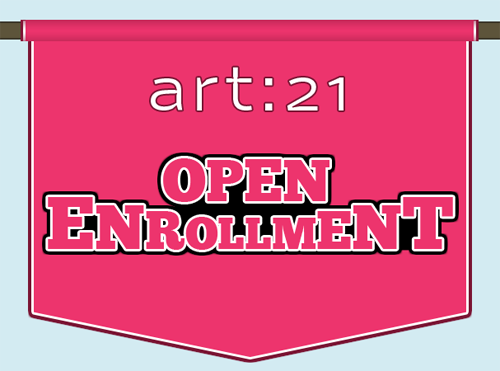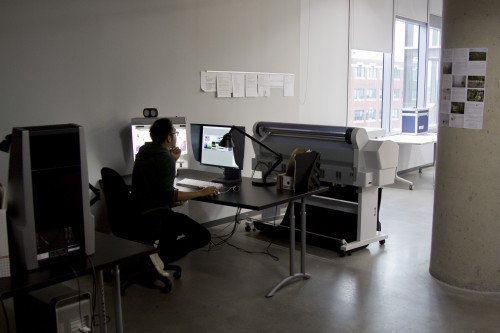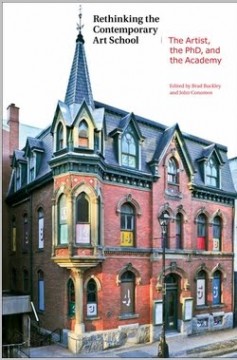For a few months now, my thesis project has hit a standstill. Unfortunately what I realized is that the stagnation of not working on it has started to corrode my daily life. I know that if this project lingers on, it will just destroy my mental health. So last week I decided to take some sort of firm action, and I found myself standing in the middle of Hexagram Concordia: Institute for Research/Creation in Media Arts and Technology trying to renew my long overdue account. In many ways, this is where the questioning of my work kicked off.
Hexagram is a facility dedicated to the exploration of new media that is worth ‘X’ millions of dollars. Luckily, the access of these provisions is not limited to professors and research-artists, but made equally available to graduate students. Here, to name a few things, there are rapid prototyping, animation labs, large format digital imaging, a computerized jacquard loom, a ProTools edit station, and an assortment of video and sound recording equipment readily at hand. And who can forget the wonderful support staff who are knowledgeable and extraordinary? Having this kind of support is real luxury for any impoverished student because the using of this equipment costs a nominal fee. Without a doubt, this type of technology and new media which Hexagram offers up is deemed as research and creation, mainly from its institutional title and that it is well-subsidized. However, for artists who do not use technologies or avoid new medias in their work, can their practice still be considered research-based?
I have to admit that I am quite obsessed and perplexed by the word “research” because I don’t know what it means. This curiosity stems from someone asking me a very delicate question about my own work. The question was simple and direct, but hit right to the heart: “tell me about your research.” Honestly, I was a little stunned by this query — thrown off to be exact — because I wasn’t sure if I did research or if my work was acceptable in accordance to the SSHRC (Social Science and Humanities Research Council of Canada) or is favorable in an academic institution. Frankly, I read books and I write about what I read, often appropriating these ideas into certain contexts related to language, the social, and cultural implications of food – plus, I cook. My work is inherently theoretically- and conceptually-based. I use new media as a vehicle to support my ideas but not vice versa. So I can say that my work is technologically nominal. If I look at the Hexagram model and I interpret technology as the baseline for art research and creation then proportionally, I am not doing any esteemed research at all. However, if I put my work into an anthropological context, my research is on the comparative studies of food and culture. The point is, there is no finite methodology to define what is artistic research and creation. If this is so, then how does public funding like that from the SSHRC get distributed? In an educational institution, how do we decided what is worthy of being researched and what is not? What is the currency of research? How do we measure it?
I remember in eighth grade, I had a hippie art teacher who wore overalls and had long hair. He told us that “art is everything.” Strangely, I still hold this little piece of information close to my heart. If this aphorism “art is everything” is a truism, then anything that an artist makes is considered art, and if we link art and research together, then “research is everything.” Yet as I trickle down this rabbit hole, things seem to get a little more complicated, more tangled than what an adolescent artist would imagine it to be, especially when I ask…can research be everything?
Associate professor Brad Buckley’s “What Is with the Ceiling! The Artist, Higher Degrees, and Research in the University Art School,” in the publication Rethinking the Contemporary Art School: The Artist, the PhD, and the Academy, asserts that the complications that arise in measuring fine art or creative work are because “[the academy] is not empirical.” In many ways, I agree with this statement, but the reality for a graduate student is a grim one — we need to work with the system if we want to continue making art for the system. Since it is so difficult to determine what is “good” art-research and “bad” art-research, my bread and butter mainly comes from a barometer called a resumé. For any kind of fellowship or grantwriting application, one of the supporting documents that artists are asked to submit is a resumé that highlights our academic achievements, including a list of publications, gallery showings, and conferences – the list can go on, more or less like a big, fat telephone book. Who can forget that portfolio and that statement of intent? The issue is, who decides which publication is more superior? Or which gallery is better? Or which conference is a cut above? Being a grad student, I spend more time writing and footnoting, arguing and restating, trying to contextualize what I am creating rather than making art. Are we making art or are we making dossiers? Will this new methodology of working kill the creativity of the artist? This is the eureka moment where one realizse that art is not everything, especially not in a university art school. Our net worth is determined by what we can contribute to the field, and our contribution is evaluated by…I’m not sure…
Is it possible to be the artist, to be the researcher, and to be the scholar without going crazy? Can we be the research-artist while maintaining balance? I can’t help wonder if we are spreading ourselves a little too thin. Perhaps this is a function of our multitasking culture. One minute we are writing proposals, the next minute we are in the studio creating things, and later we are giving a paper at a conference — yikes — where does sleep fit in? Being a young artist, naive and somewhat self-consciously ambitious, I do feel the driving force pushing me to join the rat race as it has become a do-or-die. What will be at the end of the rabbit hole? We can either get on that research bandwagon and stay in the educational system, where we will be making work for our pupils and other research-artists; or we can try to find alternatives – but what are our alternatives? The commercial? Or the looming something else?
In the attempt to renew my Hexagram account, I was given a lot to think about, particularly when I ran into administrative coordinator Momoko Allard, and sound and electronics lab coordinator Steve Bates at the photocopiers. Steve overheard my dubious rant and left me with his views on research, which he believes is founded on “R and r.” The “big R” is the research done for SSHRC and the “little r” is the research conducted in the private studio. As research-artists, we are face with a lot of dilemmas with regards to what research is, but we are also living in a very exciting time where we can watch how this notion will unfold and will most certainly alter our art practice.






